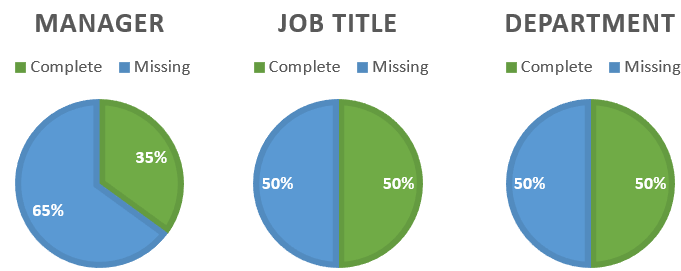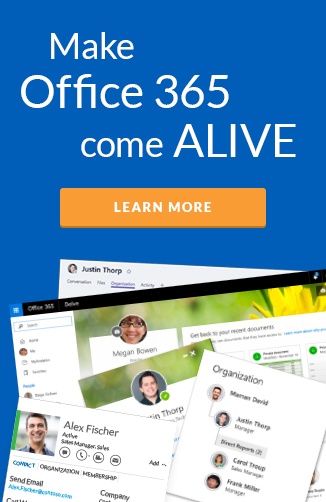Since our launch in September 2016, our free analyzer tool has been available to get a report on how complete and up-to-date your profiles are. It was no surprise to us that out of the thousands of organizations that have run the tool, over 80% of the profiles were missing critical information.
Although we don’t have access to the org’s profile data, we do see the statistics generated in the report. After hundreds of reports generated, we have started to see some interesting patterns emerge.
 Profile information is key to connect across any organization
Profile information is key to connect across any organization
1. Organization information is missing more in larger organizations
On average, organizations under 20,000 employees are typically missing over 50% of organization details. The below key attributes had surprisingly high in-completion percentages

In organizations larger than 20,000, this drops significantly:

In larger organizations IT departments are often investing more heavily in identity management systems (IDMs). Additionally larger organizations place greater effort into maintaining critical employee information such as their manager and department in a human resource management systems (HRMS); information used to drive employee processes including on-boarding, feedback, performance and salary reviews.
We are finding many organizations are not syncing manager and department information stored in their HRMS to other systems, because of the complex nature of a HRMS. In contrast we are seeing that many larger organizations allowing Job Titles to be freely updated by their employees, but lock down manager and department.
2. Organizations over 10,000 are missing 97% of employee photos
 Great Profile Photos can make a huge impact to your Office 365 experience
Great Profile Photos can make a huge impact to your Office 365 experience
On average, organizations over 10,000 employees have 97% of their photos missing. Organizations smaller than this are slightly better at maintaining employee photos; but are still on average 80% missing.
“Large organizations will often take a persons photo when an employee joins the company for their security badge. They then lock down the ability for users to change them through the tools that Office 365 offers to ensure consistency and adherence to company standards. Smaller organizations on the other hand tend to leave the default settings on for SharePoint and Office 365 that allows users to update their photo themselves.” - Chris Johnson, Hyperfish CTO
3. Critical communication information is missing from all organizations
Across all organizations who have run our analyzer, work phone was on average missing for 52% users.
It appears that many employees do not like to share their mobile phone in the profile, across the board on average 80% are missing.
“My take on this is that most don’t like to share their mobile phone because they don’t want to be contacted outside work hours. Many organizations pay for the bills and so organizations want to enforce the collection of this.” Jeremy Thake
Wrap up
From looking deeper at all of this data and our industry analysis and interactions, we came to the conclusion that larger organizations want more control of their information. The issue that results in this new control is without the correct tools, it prevents the ability for employees to provide the most up-to-date information about themselves. With defined approval processes, data entry validation rules, and real-time monitoring Hyperfish can help organizations strike the right balance of control.
So what are you waiting for? Run our free analyzer tool to see the state of your organizations profiles.

